5 Easy Steps To The Best Shrimp Linguine Recipe
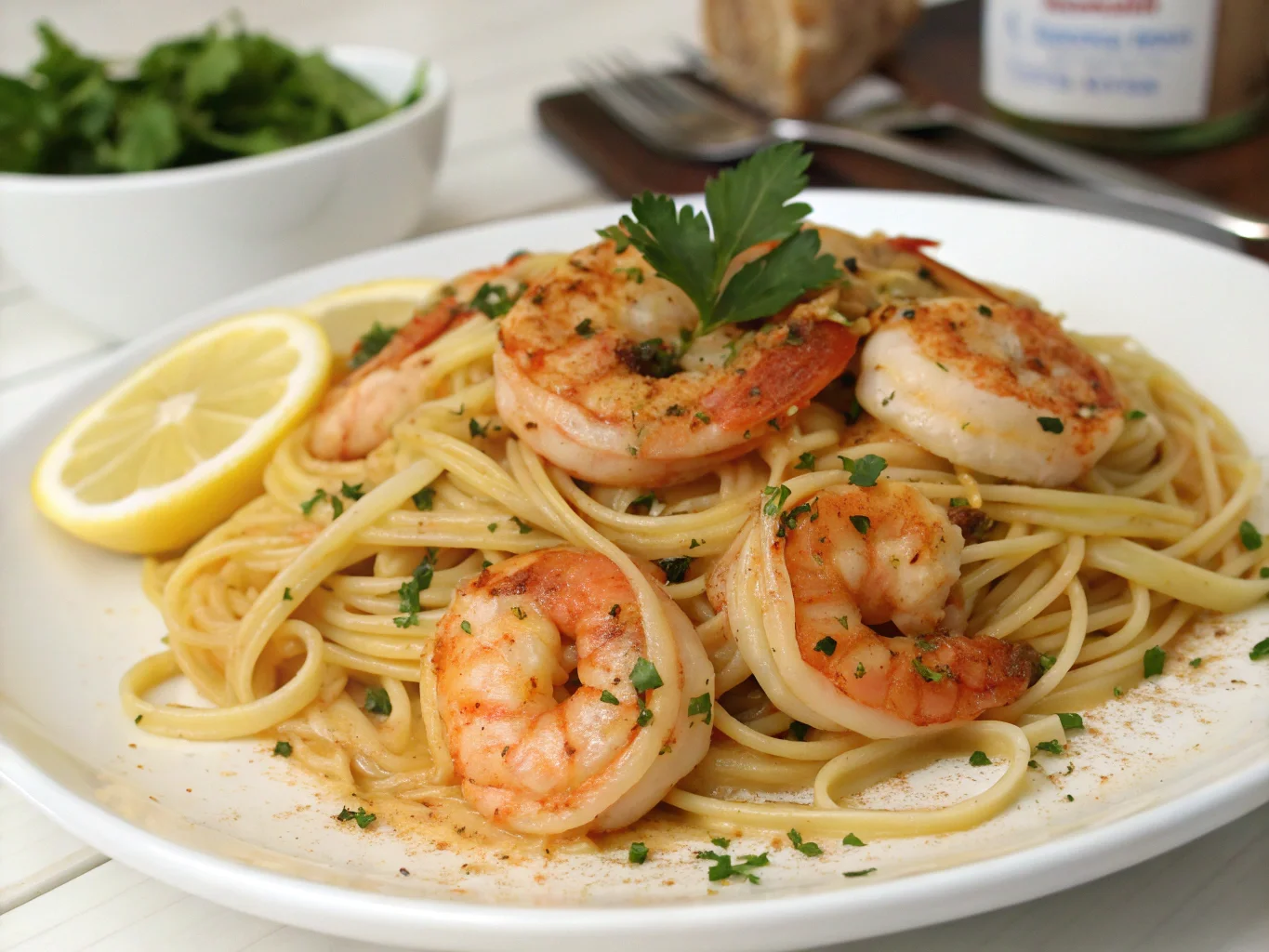
Introduction
Did you know that shrimp linguine is one of the most searched pasta recipes online, with over 50,000 monthly searches? This statistic speaks volumes about how beloved this classic dish truly is among home cooks and food enthusiasts alike. When you’re craving something that strikes the perfect balance between sophisticated and simple, this shrimp linguine recipe delivers in every way possible.
This classic shrimp linguine recipe combines tender, succulent seafood with perfectly al dente pasta strands, all coated in a rich, garlicky sauce that hits all the right notes on your palate. The beauty of this shrimp linguine recipe lies in its remarkable versatility – it’s equally at home on your weeknight dinner table as it is at your most elegant dinner parties. The delicate sweetness of the shrimp pairs magnificently with the subtle bite of garlic and the bright notes of lemon, creating a symphony of flavors that will transport you straight to a seaside Italian restaurant.
Ingredients List
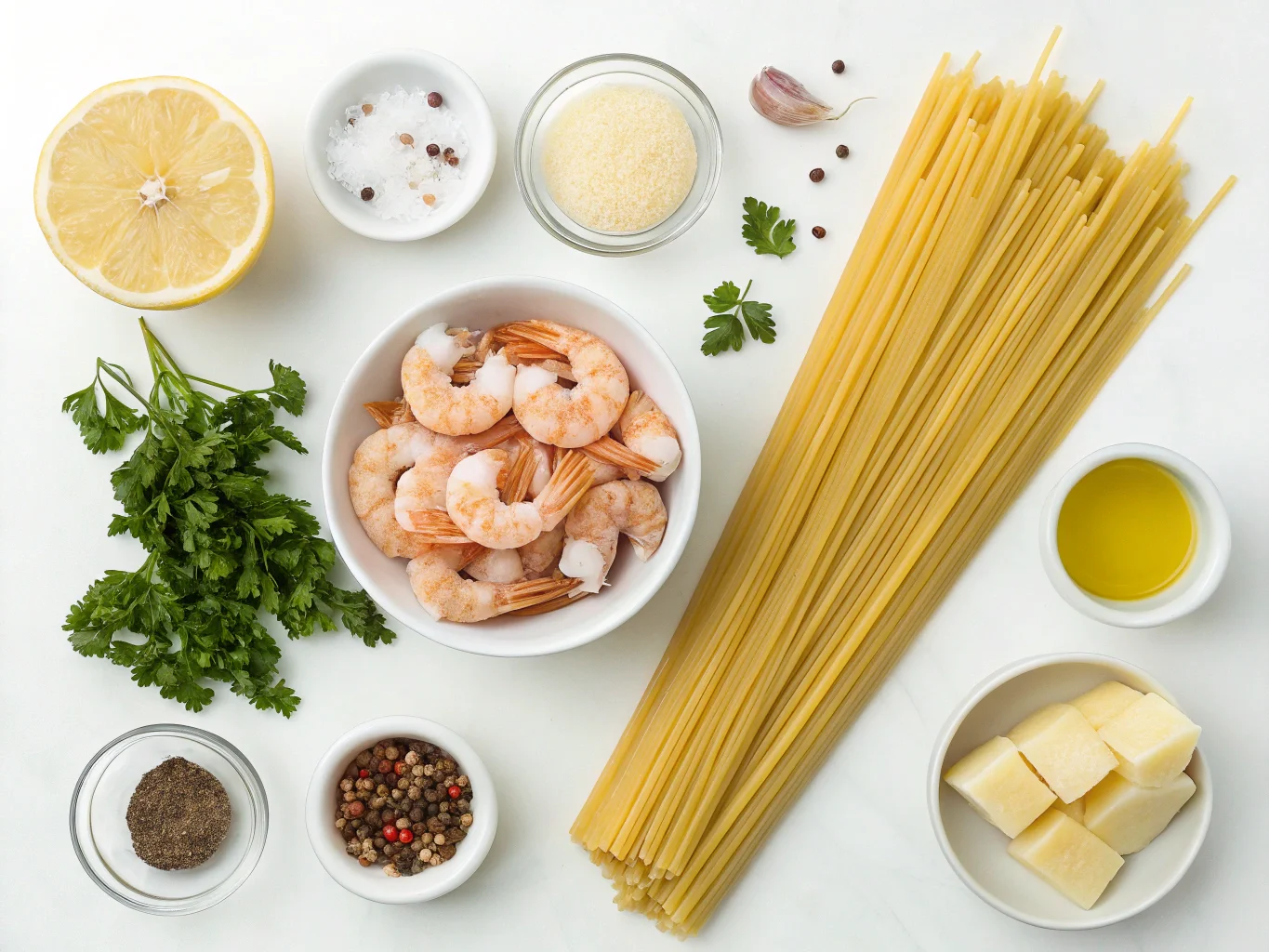
✨ For the Shrimp Linguine Recipe:
| Ingredient | Amount | Notes |
|---|---|---|
| Linguine pasta | 8 oz (225g) | Regular or whole wheat |
| Large shrimp | 1 lb (450g) | Peeled and deveined |
| Garlic | 4 cloves | Freshly minced for best flavor |
| Olive oil | 1/4 cup | Extra virgin preferred |
| Butter | 2 tbsp | Unsalted |
| White wine | 1/4 cup | Dry varieties work best |
| Lemon | 1 whole | For both juice and zest |
| Red pepper flakes | 1/2 tsp | Adjust according to spice preference |
| Fresh parsley | 1/4 cup | Finely chopped |
| Salt and pepper | To taste | Sea salt recommended |
| Parmesan cheese | 1/4 cup | Freshly grated |
🔄 Substitutions and Variations:
The versatility of this shrimp linguine recipe allows for numerous adaptations to suit your dietary needs or preferences:
● For gluten-free diets: Substitute regular linguine with gluten-free linguine made from rice, corn, or quinoa. Many high-quality brands are now available that closely mimic the texture of traditional pasta.
● For dairy-free options: Omit the Parmesan cheese entirely or replace it with nutritional yeast for a similar umami flavor profile. You can also find dairy-free Parmesan alternatives in many specialty stores.
● Protein alternatives: While this is primarily a shrimp linguine recipe, you can easily substitute or combine the shrimp with other proteins. Consider using chicken breast cut into strips, tender sea scallops, or even firm tofu cubes for a vegetarian version. Each will give a different but equally delicious twist on this shrimp linguine recipe.
● Wine substitutions: If you prefer not to use alcohol, replace the white wine with an equal amount of chicken or vegetable broth, adding a splash of lemon juice or a teaspoon of white wine vinegar to capture some of the acidity that wine would provide.
Tools and Equipment
To prepare this shrimp linguine recipe efficiently, you’ll need the following kitchen tools:
✅ Large pot: Essential for boiling pasta properly, allowing enough room for the linguine to move freely as it cooks.
✅ Large skillet or frying pan: Preferably 12 inches in diameter with higher sides to accommodate all ingredients when tossing together.
✅ Colander: For draining the pasta while reserving some cooking water.
✅ Garlic press (optional): Makes quick work of mincing garlic cloves, though a sharp knife works well too.
✅ Zester or microplane: For removing the flavorful oils from the lemon rind without including bitter pith.
✅ Measuring cups and spoons: For accurate ingredient proportions.
✅ Tongs: Perfect for tossing pasta with sauce ingredients, ensuring even coating.
🔍 Pro tip: Use a wide skillet rather than a deep pot when cooking the shrimp for this shrimp linguine recipe. The increased surface area allows the shrimp to sear rather than steam, developing a more complex, caramelized flavor that elevates the entire dish. A skillet with at least 12 inches of diameter is ideal for achieving this effect.
⏱️ Timing
Understanding the time commitment for this shrimp linguine recipe helps with meal planning:
- Preparation time: 10 minutes (cleaning shrimp, chopping garlic and herbs, measuring ingredients)
- Cooking time: 20 minutes (pasta cooking and sauce preparation occur simultaneously)
- Total time: 30 minutes from start to finish
Step-by-Step Guide
1️⃣ Prepare the Pasta Base
Bring a large pot of water to a rolling boil. Add 1-2 tablespoons of salt (the water should taste like seawater) – this is crucial for properly seasoned pasta in your shrimp linguine recipe. Add the linguine and cook according to package instructions until al dente (usually 8-10 minutes). Stir occasionally during the first couple of minutes to prevent sticking.
While perfectly cooked pasta should have a slight bite to it, remember that the linguine will continue to cook slightly when added to the hot sauce later, so aim for the lower end of the recommended cooking time. This ensures your finished shrimp linguine recipe won’t feature overcooked, mushy pasta.
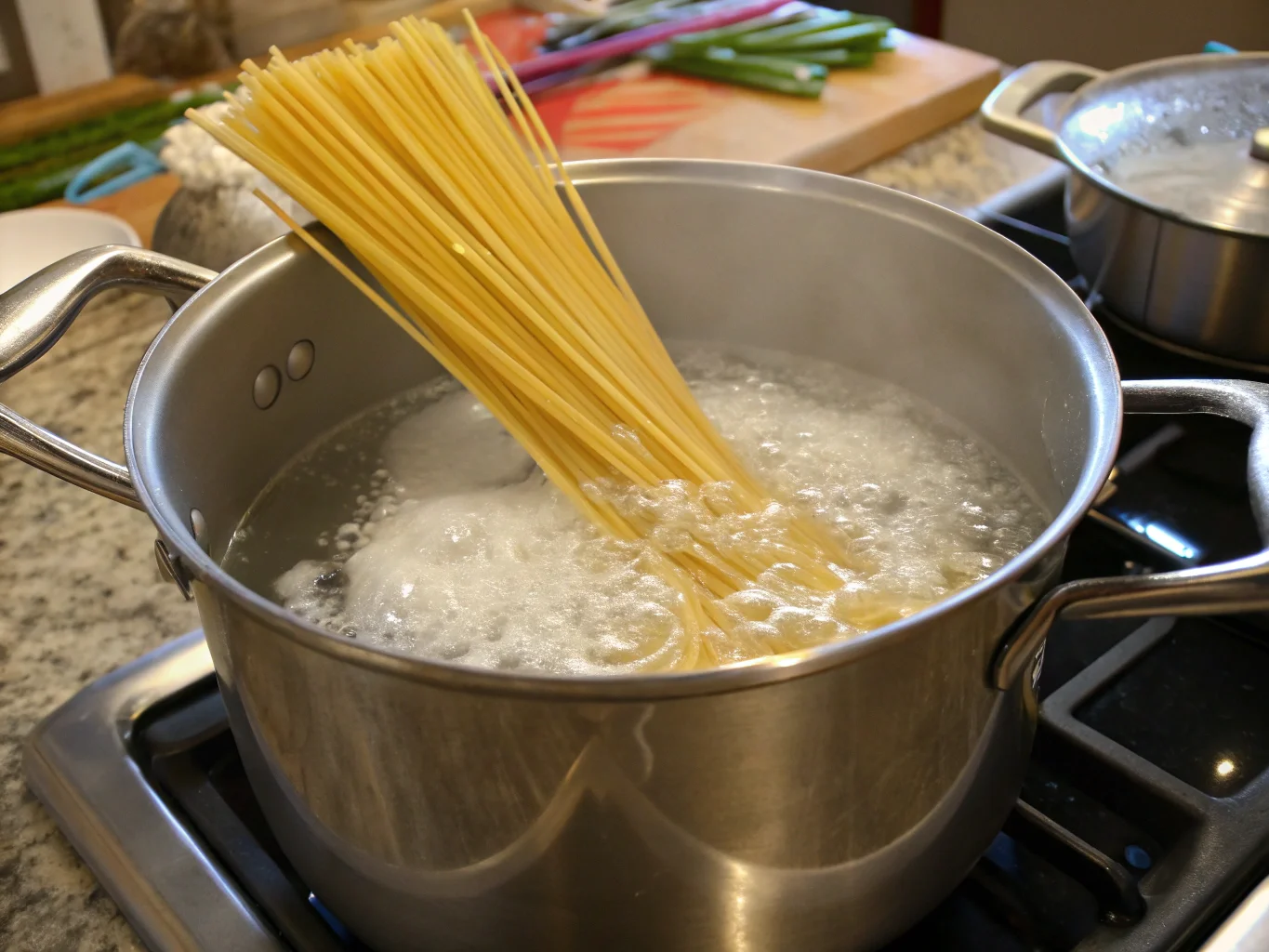
2️⃣ Prepare the Shrimp
While the pasta cooks, turn your attention to preparing the shrimp for your shrimp linguine recipe. First, pat them dry thoroughly with paper towels. This step is absolutely essential for achieving a good sear rather than steaming the shrimp, which would result in a less flavorful final dish.
If your shrimp are particularly large, consider cutting them in half crosswise to create pieces that are more manageable and will distribute more evenly throughout the pasta. This allows for getting a bit of shrimp in every delicious bite of your completed shrimp linguine recipe.
3️⃣ Cook the Shrimp
Heat olive oil and 1 tablespoon of butter in a large skillet over medium-high heat until the butter is melted and the mixture is shimmering but not smoking. Carefully add the shrimp in a single layer (avoid crowding) and cook for 1-2 minutes per side until they turn pink and opaque. They should form a loose “C” shape when properly cooked.
Once cooked, remove the shrimp to a clean plate and set aside. They’ll be added back to the shrimp linguine recipe in the final steps.
🔍 Pro tip: Avoid overcrowding the pan when cooking shrimp – work in batches if necessary for the best results in your shrimp linguine recipe. Overcrowding causes the shrimp to release moisture and steam rather than sear, resulting in less flavor development and potentially rubbery texture.
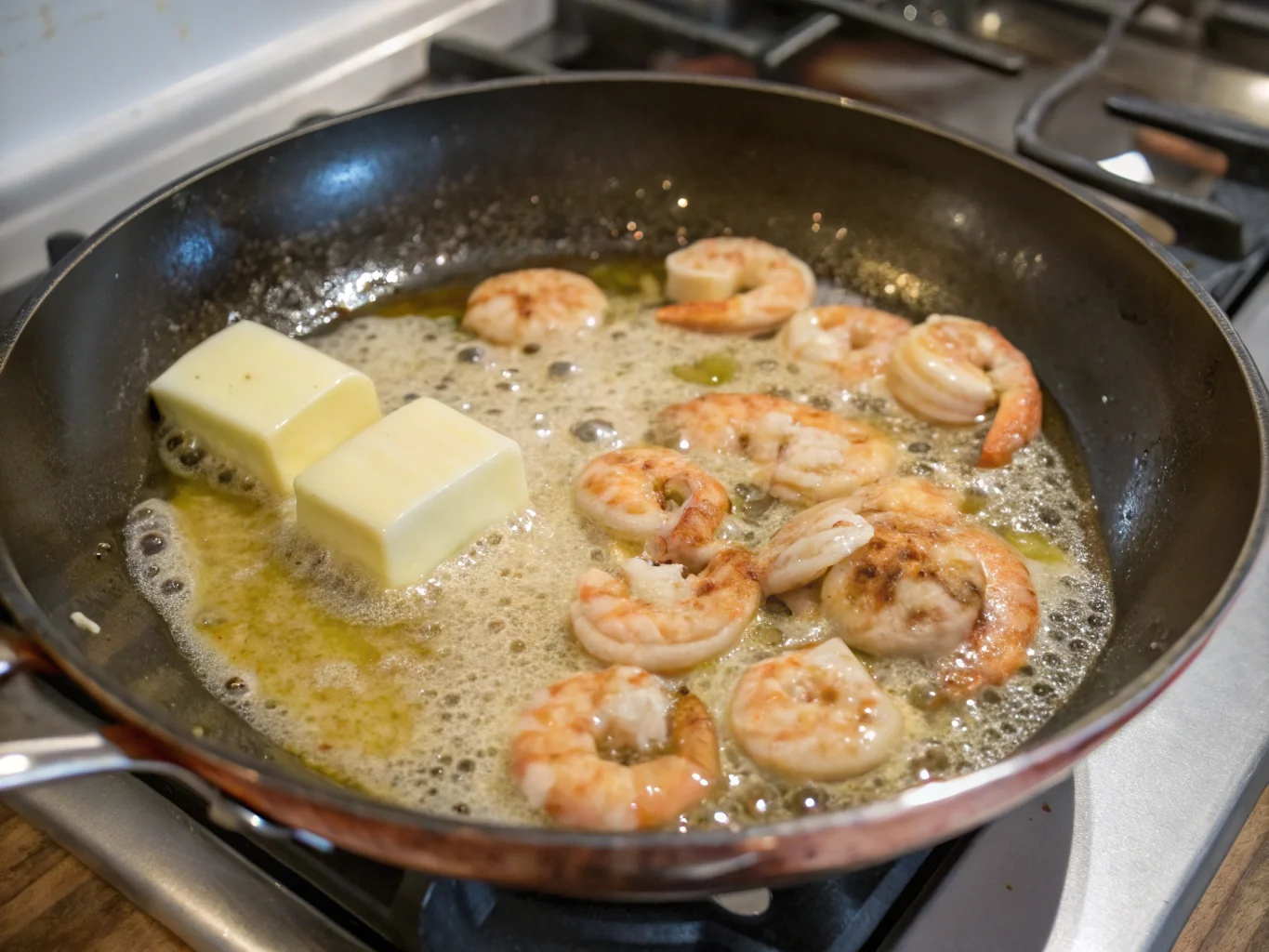
4️⃣ Create the Flavor Base
In the same skillet (don’t clean it!), reduce heat to medium and add the minced garlic and red pepper flakes. The residual oil and butter will help bloom these aromatics without burning them. Cook for just 30 seconds until the garlic becomes fragrant but doesn’t brown, as browned garlic can add bitterness to your shrimp linguine recipe.
This short cooking process releases the essential oils in both the garlic and pepper flakes, infusing the fat with their flavors and creating a aromatic foundation for your sauce.
5️⃣ Develop the Sauce
Add the white wine and freshly squeezed lemon juice to the skillet. The liquid will sizzle as it hits the hot pan, helping to deglaze the surface by loosening any browned bits from cooking the shrimp. These browned bits (called fond) contain concentrated flavors that will enrich your shrimp linguine recipe sauce.
Allow this mixture to simmer for about 2 minutes, which accomplishes two things: it burns off the alcohol in the wine and reduces the liquid slightly, concentrating the flavors that will coat your pasta.
6️⃣ Prepare the Pasta for Sauce
When the linguine is cooked to al dente perfection, drain it in a colander, but be sure to reserve approximately 1/2 cup of the starchy pasta cooking water first. This cloudy water contains starches that will help thicken your sauce and create the silky texture that characterizes an authentic Italian pasta dish.
Never rinse your pasta after cooking when making this shrimp linguine recipe (or any pasta dish). Rinsing would wash away the surface starches that help the sauce adhere to the linguine.

7️⃣ Combine Pasta and Sauce
Add the drained linguine directly to the skillet with the sauce. Add the remaining tablespoon of butter and toss everything together with tongs, coating each strand of pasta with the flavorful sauce. The residual heat from both the pasta and the skillet will melt the butter, adding richness and helping to create an emulsified sauce for your shrimp linguine recipe.
If the mixture seems too dry or the sauce isn’t coating the pasta well, add a small amount of the reserved pasta water, a couple of tablespoons at a time. The starchy water will help create a silky sauce that clings to both the pasta and the shrimp.
8️⃣ Reintroduce the Shrimp
Return the cooked shrimp to the skillet, along with any juices that have accumulated on the plate. These juices contain concentrated shrimp flavor that will enhance your sauce. Gently fold the shrimp into the pasta mixture, distributing them evenly throughout the dish.
Continue to add small amounts of the reserved pasta water if needed to maintain a loose, silky sauce consistency. The goal is to have a sauce that coats each strand of linguine without pooling in the bottom of the pan.

9️⃣ Add Final Flavor Elements
Sprinkle the lemon zest, chopped fresh parsley, and grated Parmesan cheese over the pasta. The lemon zest adds bright citrus notes, the parsley brings fresh, herbaceous elements, and the Parmesan contributes salty, umami richness to complete your shrimp linguine recipe.
Season with salt and freshly ground black pepper to taste. Remember that Parmesan cheese is salty, so taste the dish before adding additional salt.
🔟 Final Toss and Serve
Toss everything together until well combined and heated through, about 1-2 minutes more over medium heat. The pasta should be glossy with sauce, and every bite should contain a harmonious blend of flavors from your shrimp linguine recipe.
Serve immediately in warmed pasta bowls or plates, garnished with additional parsley and Parmesan if desired. The warmth of the plate or bowl helps keep your shrimp linguine recipe at the optimal temperature as you enjoy it.
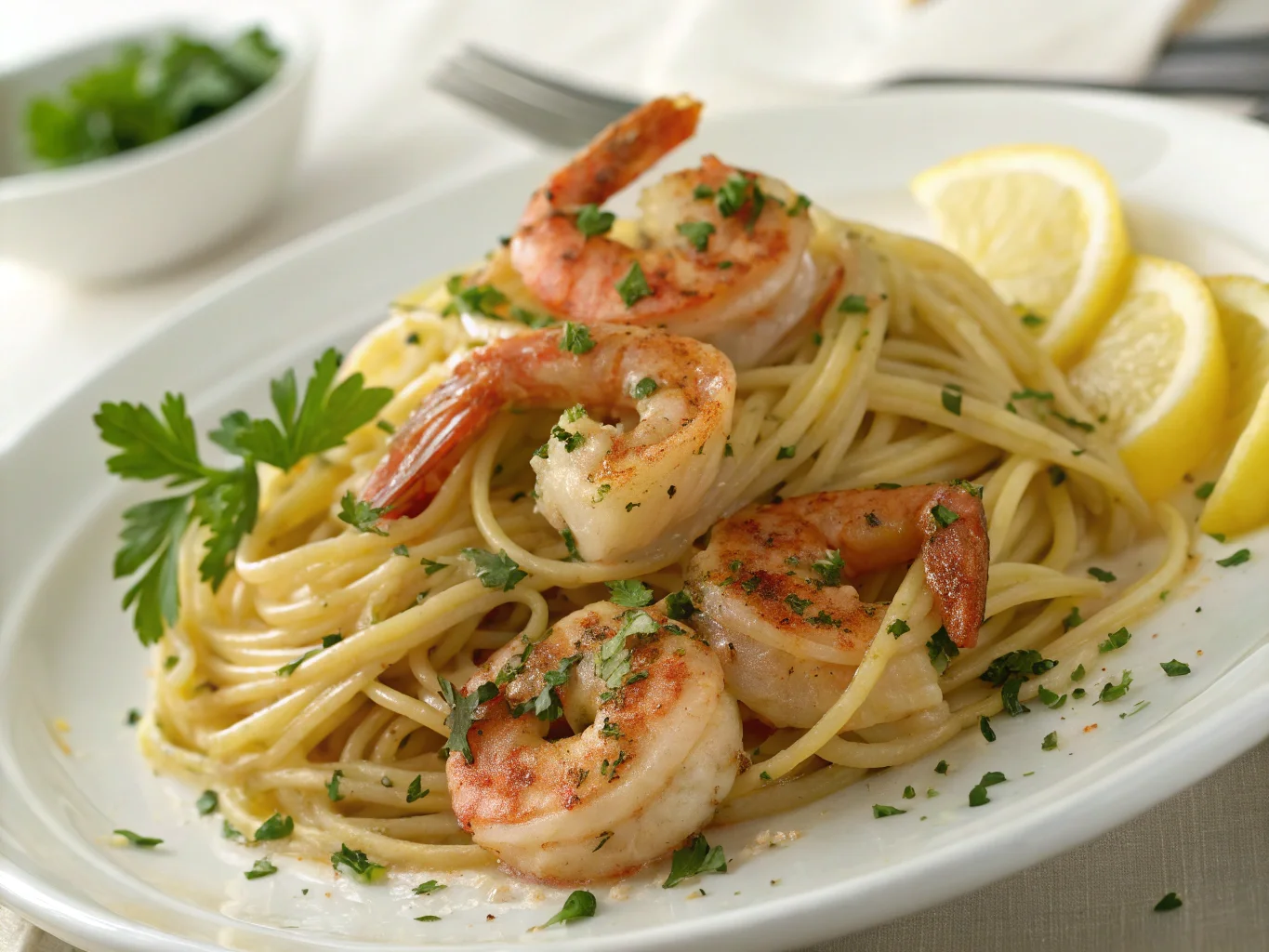
Pro Cooking Tips
✅ Expert Advice:
● Pasta perfection: Cook pasta just until al dente for this shrimp linguine recipe – it will continue cooking slightly when added to the hot sauce. Testing a strand about a minute before the package’s suggested cooking time helps achieve the perfect texture.
● Shrimp selection: Use large or jumbo shrimp (21-30 count per pound) for the best texture in this shrimp linguine recipe. They maintain their succulence better during cooking and provide more substantial bites in the finished dish.
● Pasta water magic: The importance of saving some pasta water for this shrimp linguine recipe cannot be overstated. This starchy liquid is the secret to creating a silky sauce that perfectly adheres to both pasta and shrimp, creating cohesion between all elements of the dish.
● Flavor boosting: For extra depth of flavor, try marinating the peeled and deveined shrimp in a mixture of 2 tablespoons olive oil, 1 clove minced garlic, and 1 teaspoon lemon zest for 15 minutes before cooking. This brief marination infuses the shrimp with complementary flavors that enhance the overall profile of your shrimp linguine recipe.
● Wine selection: When choosing a white wine for this shrimp linguine recipe, opt for dry varieties like Pinot Grigio, Sauvignon Blanc, or unoaked Chardonnay. The crisp acidity of these wines balances the richness of the butter and complements the sweetness of the shrimp.
⚠️ Mistakes to Avoid
Even experienced cooks can fall prey to these common errors when preparing a shrimp linguine recipe:
🔶 Neglecting pasta water salinity: Not seasoning the pasta water sufficiently is a fundamental error. The water should taste like sea water, as this is the only opportunity to season the pasta itself from within rather than just coating it with flavored sauce.
🔶 Rinsing cooked pasta: This critical mistake removes the starch that helps the sauce adhere. When preparing this shrimp linguine recipe, always transfer the pasta directly from colander to sauce without rinsing.
🔶 Overcooking seafood: Shrimp cook extremely quickly and continue cooking from residual heat. They should be just pink and opaque – if they curl into tight circles, they’re overcooked and will likely be rubbery in your shrimp linguine recipe.
🔶 Ingredient quality compromises: Using low-quality ingredients significantly impacts the final result. This is especially important for the olive oil, which provides foundational flavor, and the Parmesan cheese, which adds complex umami notes to your shrimp linguine recipe.
🔶 Inadequate pasta water reservation: Forgetting to reserve pasta water before draining leaves you without a crucial ingredient for creating a cohesive sauce. Place a measuring cup next to the stove as a visual reminder when making this shrimp linguine recipe.
🔶 Inconsistent shrimp sizing: Using mixed sizes of shrimp results in uneven cooking – smaller ones become overcooked while larger ones remain underdone. Select uniform-sized shrimp for the most consistent results in your shrimp linguine recipe.
Nutritional Information
Understanding the nutritional profile of this shrimp linguine recipe helps you make informed dietary choices:
Per serving (based on 4 servings):
| Nutrient | Amount |
|---|---|
| Calories | 420 |
| Protein | 28g |
| Carbohydrates | 40g |
| Fat | 16g |
| Fiber | 2g |
| Sodium | 310mg |
❓ FAQ Section
🦐 Can I use frozen shrimp for this shrimp linguine recipe?
Yes! Frozen shrimp are high-quality since they’re frozen soon after harvest. Thaw them under cold running water for 5 minutes or overnight in the fridge. Pat dry before cooking for proper searing. Use raw shrimp instead of pre-cooked to avoid toughness.
🔍 How do I know when the shrimp are perfectly cooked?
SShrimp turn from translucent gray to opaque pink and curl into a loose “C” shape when perfectly cooked. If they form a tight “O,” they’re overcooked. Cook 1-2 minutes per side over medium-high heat.
⏰ Can I make this shrimp linguine recipe ahead of time?
It’s best fresh, but you can prep components separately—slightly undercook the pasta, prepare the sauce, and clean the shrimp. Store them separately and finish cooking before serving.
🍷 What can I substitute for white wine?
Use chicken or vegetable broth instead. Add a tablespoon of lemon juice or a teaspoon of white wine vinegar for acidity.
❄️ Is this shrimp linguine recipe suitable for freezing?
Not recommended—pasta gets mushy, and shrimp turn rubbery. For best results, enjoy fresh or within 1-2 days.
🍤 What size shrimp works best for this recipe?
Large (31-35 count/lb) or jumbo (21-30 count/lb) shrimp work best. They stay tender and hold up to the pasta. Smaller shrimp get lost, while larger ones need more precise cooking.

5 Easy Steps To The Best Shrimp Linguine Recipe
Ingredients
- Linguine pasta 8 oz 225g Regular or whole wheat
- Large shrimp 1 lb 450g Peeled and deveined
- Garlic 4 cloves Freshly minced for best flavor
- Olive oil 1/4 cup Extra virgin preferred
- Butter 2 tbsp Unsalted
- White wine 1/4 cup Dry varieties work best
- Lemon 1 whole For both juice and zest
- Red pepper flakes 1/2 tsp Adjust according to spice preference
- Fresh parsley 1/4 cup Finely chopped
- Salt and pepper To taste Sea salt recommended
- Parmesan cheese 1/4 cup Freshly grated
Instructions
- Prepare the Pasta BaseToss everything together until well combined and heated through, about 1-2 minutes more over medium heat. The pasta should be glossy with sauce, and every bite should contain a harmonious blend of flavors from your shrimp linguine recipe.Serve immediately in warmed pasta bowls or plates, garnished with additional parsley and Parmesan if desired. The warmth of the plate or bowl helps keep your shrimp linguine recipe at the optimal temperature as you enjoy it.Bring a large pot of water to a rolling boil. Add 1-2 tablespoons of salt (the water should taste like seawater) – this is crucial for properly seasoned pasta in your shrimp linguine recipe. Add the linguine and cook according to package instructions until al dente (usually 8-10 minutes). Stir occasionally during the first couple of minutes to prevent sticking.While perfectly cooked pasta should have a slight bite to it, remember that the linguine will continue to cook slightly when added to the hot sauce later, so aim for the lower end of the recommended cooking time. This ensures your finished shrimp linguine recipe won’t feature overcooked, mushy pasta. 2. Prepare the ShrimpWhile the pasta cooks, turn your attention to preparing the shrimp for your shrimp linguine recipe. First, pat them dry thoroughly with paper towels. This step is absolutely essential for achieving a good sear rather than steaming the shrimp, which would result in a less flavorful final dish.If your shrimp are particularly large, consider cutting them in half crosswise to create pieces that are more manageable and will distribute more evenly throughout the pasta. This allows for getting a bit of shrimp in every delicious bite of your completed shrimp linguine recipe.3. Cook the ShrimpHeat olive oil and 1 tablespoon of butter in a large skillet over medium-high heat until the butter is melted and the mixture is shimmering but not smoking. Carefully add the shrimp in a single layer (avoid crowding) and cook for 1-2 minutes per side until they turn pink and opaque. They should form a loose “C” shape when properly cooked.Once cooked, remove the shrimp to a clean plate and set aside. They’ll be added back to the shrimp linguine recipe in the final steps. 4. Create the Flavor BaseIn the same skillet (don’t clean it!), reduce heat to medium and add the minced garlic and red pepper flakes. The residual oil and butter will help bloom these aromatics without burning them. Cook for just 30 seconds until the garlic becomes fragrant but doesn’t brown, as browned garlic can add bitterness to your shrimp linguine recipe.This short cooking process releases the essential oils in both the garlic and pepper flakes, infusing the fat with their flavors and creating a aromatic foundation for your sauce.5. Develop the SauceAdd the white wine and freshly squeezed lemon juice to the skillet. The liquid will sizzle as it hits the hot pan, helping to deglaze the surface by loosening any browned bits from cooking the shrimp. These browned bits (called fond) contain concentrated flavors that will enrich your shrimp linguine recipe sauce.Allow this mixture to simmer for about 2 minutes, which accomplishes two things: it burns off the alcohol in the wine and reduces the liquid slightly, concentrating the flavors that will coat your pasta.6. Prepare the Pasta for SauceWhen the linguine is cooked to al dente perfection, drain it in a colander, but be sure to reserve approximately 1/2 cup of the starchy pasta cooking water first. This cloudy water contains starches that will help thicken your sauce and create the silky texture that characterizes an authentic Italian pasta dish.Never rinse your pasta after cooking when making this shrimp linguine recipe (or any pasta dish). Rinsing would wash away the surface starches that help the sauce adhere to the linguine.7. Combine Pasta and SauceAdd the drained linguine directly to the skillet with the sauce. Add the remaining tablespoon of butter and toss everything together with tongs, coating each strand of pasta with the flavorful sauce. The residual heat from both the pasta and the skillet will melt the butter, adding richness and helping to create an emulsified sauce for your shrimp linguine recipe.If the mixture seems too dry or the sauce isn’t coating the pasta well, add a small amount of the reserved pasta water, a couple of tablespoons at a time. The starchy water will help create a silky sauce that clings to both the pasta and the shrimp.8. Reintroduce the ShrimpReturn the cooked shrimp to the skillet, along with any juices that have accumulated on the plate. These juices contain concentrated shrimp flavor that will enhance your sauce. Gently fold the shrimp into the pasta mixture, distributing them evenly throughout the dish.Continue to add small amounts of the reserved pasta water if needed to maintain a loose, silky sauce consistency. The goal is to have a sauce that coats each strand of linguine without pooling in the bottom of the pan.9. Add Final Flavor ElementsSprinkle the lemon zest, chopped fresh parsley, and grated Parmesan cheese over the pasta. The lemon zest adds bright citrus notes, the parsley brings fresh, herbaceous elements, and the Parmesan contributes salty, umami richness to complete your shrimp linguine recipe.Season with salt and freshly ground black pepper to taste. Remember that Parmesan cheese is salty, so taste the dish before adding additional salt.10. Final Toss and ServeToss everything together until well combined and heated through, about 1-2 minutes more over medium heat. The pasta should be glossy with sauce, and every bite should contain a harmonious blend of flavors from your shrimp linguine recipe.Serve immediately in warmed pasta bowls or plates, garnished with additional parsley and Parmesan if desired. The warmth of the plate or bowl helps keep your shrimp linguine recipe at the optimal temperature as you enjoy it.

Conclusion
This delicious shrimp linguine recipe offers a perfect balance of flavors – garlicky, lemony, and rich with perfectly cooked seafood and pasta. The tender shrimp provide sweet, oceanic notes that complement the al dente linguine, while the sauce brings everything together with bright acidity from lemon and wine, richness from butter and olive oil, and aromatic depth from garlic and herbs.
Ready in just 30 minutes, this shrimp linguine recipe is both weeknight-friendly and special enough for entertaining, making it an invaluable addition to any home cook’s repertoire. The straightforward preparation belies the sophisticated flavor profile, giving you maximum impact for minimal effort.
There are no reviews yet. Be the first one to write one.
